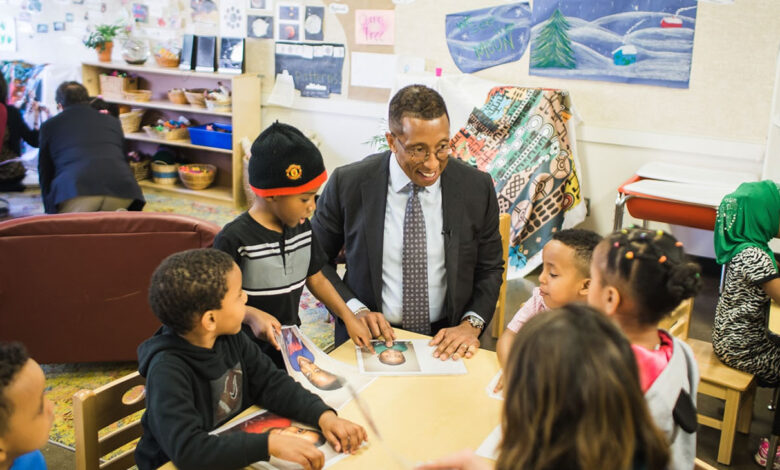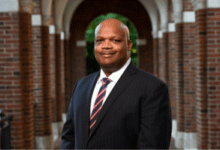
It’s Time to Reflect On, Reinvent, and Innovate Our Education Systems
By Allan Gibson
I look forward to the holidays because it’s a time when we gather to celebrate friends and family and cherish what’s most important to us. It’s also a time of reflection and an opportunity people often use to evaluate and reset their goals as they look ahead to the start of a new year.
But as I reflect on this past year-and-a-half and note the continuing impacts of the pandemic, this moment feels like no other. It calls for both addressing existing, immediate challenges while also seizing opportunities to strengthen our education systems for the long term, addressing the needs of educators and students alike.
With the COVID-19 vaccine now available to children five years and older, schools may no longer have to grapple as much with polarizing reopening decisions, but they are still left to manage daily health and mitigation strategies for students and staff. And the potential impacts of the Omicron variant are still unknown.
Although many of us will be traveling to visit family and friends this season, gathering at restaurants, and feeling some semblance of normalcy, we should remember that what our students continue to experience in schools is far from normal. Make no mistake, families are still struggling, and the ongoing trauma of the pandemic has taken a toll on our students’ and teachers’ well-being.
The pandemic exacerbated existing inequities in education that have serious implications for students’ learning and trajectories.
In a recent blog post, I shared examples that highlight the importance of schools and educators understanding students’ needs and perspectives and centering student voice in re-evaluating initiatives.
The pandemic continues to generate significant operations challenges for school leaders, including districts reporting teacher shortages due to early retirement and resignations. A recent EdWeek Research Center survey found that 40 percent of district leaders and principals describe their overall school staffing shortages (teachers, bus drivers, custodians, cafeteria workers, etc.) as “severe” or “very severe.”
In addition, a survey by RAND Corp. found that nearly one in four teachers was likely to leave the profession by the end of the 2020–2021 school year, compared with one in six pre-pandemic. More teachers reported frequent job-related stress and depression than the general adult population.
Supporting educators’ well-being is a critical part of any successful K-12 recovery strategy. As teachers shared in a study conducted by the Yale Center for Emotional Intelligence and the Collaborative for Social Emotional and Academic Learning, that recovery should include time to adjust to the new normal; honesty, respect, kindness, flexibility, and patience from administrators and realistic expectations.
School districts are responding with virtual support groups facilitated by mental health partners, dedicated call lines for teachers and principals that connect them to support resources, and strategies that build emotional check-ins into meetings.
In this moment of reflection, as challenging as it is, I encourage our school leaders to look ahead to the start of something new with a focus on reinvention and innovation and to balance the near-term with the longer-term.
We’re starting to see some exemplars now. The National School Boards Association(NSBA) highlighted a few school districts around the country that are rethinking instructional delivery models and personalized learning, and are working to close the homework gap.
For example, Guilford County Schools (GCS) in North Carolina has allowed every student to supplement synchronous learning by taking asynchronous classes using the best GCS teachers through pre-recorded lessons. This flexibility allows students to view lessons and complete assignments on their schedules while freeing up the time of their classroom teacher to focus more on individual student needs.
As state, district, and school leaders think of approaches and investments that address students’ longer-term trajectories, it is important to remember that funding is available through the Elementary and Secondary School Emergency Relief Program (ESSER) and the Governor’s Emergency Education Relief Program (GEER) to reinvent, innovate, and strengthen long-term student-centered strategies. The foundation is supporting Invest Forward, a collaborative effort that encourages district and state leaders to prioritize support for students’ pathways to postsecondary and career success in their spending plans.
This includes strategies such as paying college application fees for students experiencing poverty, investing in summer bridge programs to help students make the successful transition to postsecondary education, and supporting the salaries of additional guidance counselors to assist students exploring postsecondary and career options or navigating the college application process.
Evidence shows that strong advising, dual enrollment, internships, and other supports increase students’ chances of progressing significantly.
Through ESSER funding, 79 school districts in Tennessee, over half of all districts in the state, are planning to participate in the Tennessee Accelerating Literacy and Learning Corps (TN ALL Corps) tutoring program as part of addressing learning loss and accelerating student achievement.
As we reflect on the past year-and-a-half, it’s also a time to be hopeful and invigorated about the future. There’s no question that our K-12 education system is resilient, will rebound and will reinstate some aspects of pre-pandemic normalcy. Moreover, we should focus on proven and cutting edge ways to make our education system more equitable and impactful for all students, including a reinvention of instructional practice, the allocation of student-centered resources, and a commitment to student and teacher well-being and supports.
Let’s not only reflect on how formidable the pandemic has been but let’s learn from its effects on our schools and innovate our instructional delivery models. Now is the time to explore new ways to increase student achievement as we look ahead to the new “normal” – or even something better.










